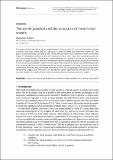The loi de position and the acoustics of French mid vowels
Author(s)
Storme, Benjamin
Download300-5680-1-PB.pdf (1.092Mb)
Publisher with Creative Commons License
Publisher with Creative Commons License
Creative Commons Attribution
Terms of use
Metadata
Show full item recordAbstract
This paper reports the results of two experiments on the acoustics of French mid vowels in a variety in which close-mid vowels ([e], [ø], [o]) occur in open syllables and open-mid vowels ([ɛ], [oe], [ɔ]) in closed syllables, according to the loi de position. Open-mid allophones have consistently higher F1 realizations and more central F2 realizations than their close-mid counterparts, but are not consistently shorter. These results are problematic for accounts of the loi de position as a pattern of vowel reduction, with mid-vowel lowering and centralizing being caused by shortening. F1 and F2 distances between close-mid and open-mid allophones vary across different prosodic and consonantal contexts and these variations can be analyzed as resulting from duration-based undershoot. More broadly, the results have implications for the typology of closed-syllable vowel laxing: they suggest that tense and lax realizations cannot generally be derived from the same acoustic target via closed-syllable vowel shortening but have distinct acoustic targets.
Date issued
2017-07Department
Massachusetts Institute of Technology. Department of Linguistics and PhilosophyJournal
Glossa
Publisher
Ubiquity Press, Ltd.
Citation
Storme, B. "The loi de position and the acoustics of French mid vowels." Glossa 2,1 (July 2017): 64 © 2017 The Author
Version: Final published version
ISSN
2397-1835
Collections
The following license files are associated with this item: